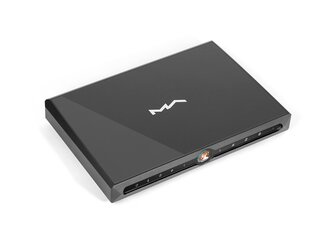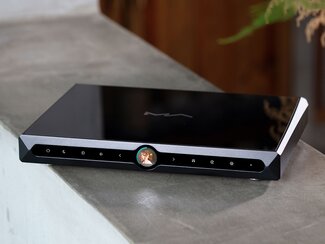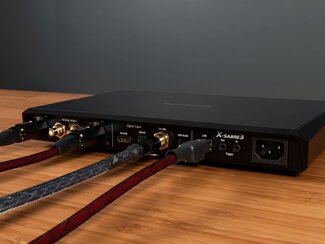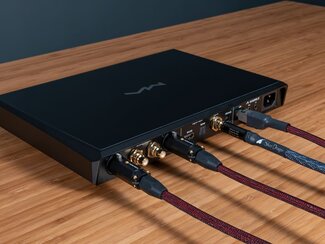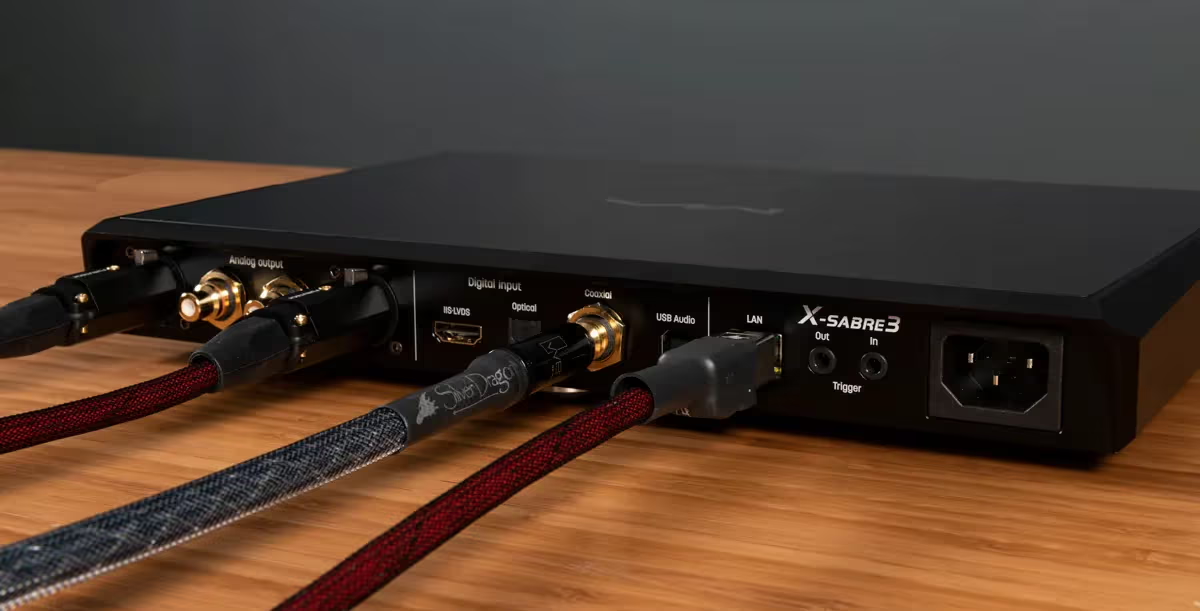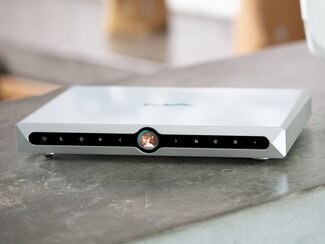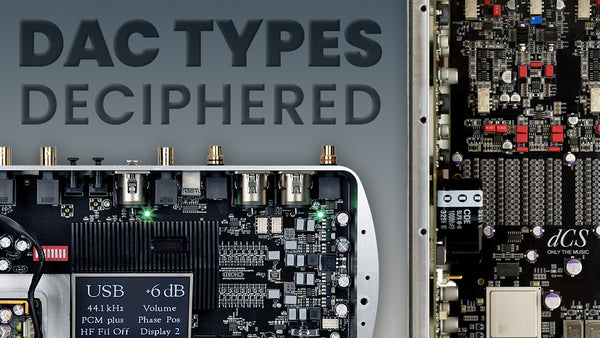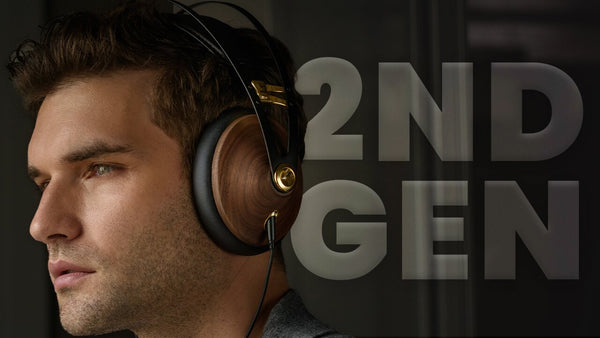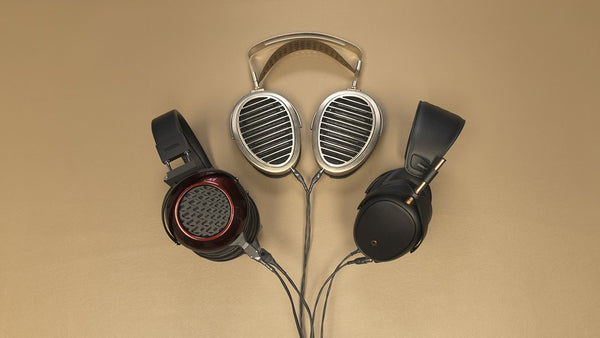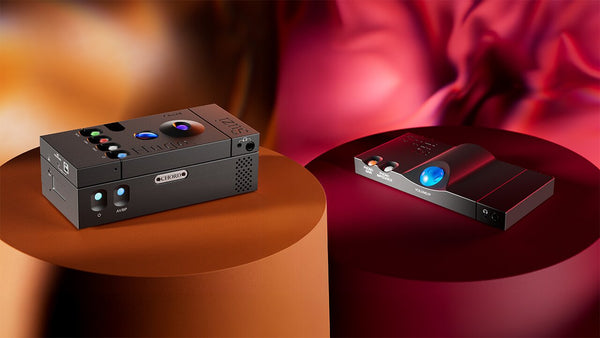Matrix Audio X-SABRE 3 DAC Review
Read Time: Approx. 18 min.

The IMAX of DACs
Do you remember the first time you saw a movie on the big screen? What about a huge IMAX screen? It's like you didn't know there was that much to see - the size of the picture, the level of detail, the vibrancy of the colors. It was experiencing something for the first time, and that can always be exciting. In a similar fashion, the Matrix Audio X-SABRE 3 DAC makes some substantial improvements that bring new amounts of detail and features - so much that it's like rediscovering your music all over again. That's not sales speak y'all - It's just a matter of fact. Don't believe me? Let's take a look at some things that I dare say make this one of the best hifi DACs on the market.
Matrix Audio X-SABRE 3 MQA DAC Streamer Review

PROS
- Great Sabre ES Sound: Clarity and detail
- Design is sleek
- Good streaming functionality
CONS
- Screen is too small to be useful at a distance
- Fingerprint magnet
Design
Matrix Audio knows how to make a chassis, and although the form factor might not look a lot different from the original X-SABRE, upgrades have been made. One of the first things you'll notice is the color LCD screen on the front of the streamer. Although the dimensions of the circular screen have stayed the same since the last generation, the addition of the full-color screen is nice and able to display album art. The screen is sharp and detailed, but I find it difficult to think it would be useful if you weren't sitting right next to the unit. It's small, and although the numeral displays are easily read, anything outside of that would be difficult to make out at distance. Still, it's a nice upgrade from the original X-SABRE, and I'm always a fan of more information on the screen. Matrix Audio did a great job with the layout as well - without crowding the small screen.
There have been some notable upgrades to the chassis construction as well. The new X-SABRE 3 is 10mm wider and 2mm lower than the previous generation, giving the box a sleek and slim aesthetic that I'm a big fan of. All the angles and sharp lines are still there - which is great - because it's one of the best designs for a chassis that still holds up today. You know what they say: if it ain't broke. The top of the chassis is now protected by a layer of tempered glass, giving off a more premium design feel than that of the brushed metal of the original. The logo is now a reflective silver, standing out much more through the glossy back glass. The only downside of the glass top is that now the device is a fingerprint magnet, and accumulated dust will show up easier. However, I think it looks much better than the previous generation despite these minor gripes.
The front panel of the DAC remains the same with the touch-sensitive backlit buttons. From left to right you'll find:
- Power on/off
- Dark mode (turns LEDs off)
- Source select
- Mute
- Back arrow
- LED Screen
- Forward arrow
- Filter Settings
- Sync
- Settings
The back of the unit also has a revamped design with the following ports (from left to right):
- Audio Output: XLR & RCA (left and right channels)
- Audio Input:
- IIS-LVDS
- Optical
- Coaxial RCA
- USB Audio
- LAN
- Trigger out
- Trigger in
- Power
Don't worry, you don't have an LED out on the furthest right side to balance the icons–it's reversed for the IR signal from the remote. The unit is sturdy and hefty. Considering the internals, metal chassis, glass, and other materials, it feels like a top-end product. At the bottom of the device, you'll find 3 feet - two in the front and one centered in the back. These feet are designed wonderfully to minimize external vibrations for the unit and balance the unit nicely. I like the weight of the X-SABRE 3: it's really heavy. You probably don't want to put this on a flimsy console or other product that can't take the weight. Aesthetically I put it up there with the Uniti Atom HE: it's a sexy piece of equipment and the sleek and angular design of the chassis is admirable. Combined with an intuitive interface and you have a box that's just asking you to press buttons and play music.
The included rm2 remote control is simple but effective. Push a button and the corresponding action on the device is enabled. Build quality is also great, made from what feels like an aluminum faceplate and a hard plastic backing. The subtle concave silver ring around each button is a lovely premium touch, showing off what premium can look like on a grossly simple design.
Sound
It'll be interesting to hear that the new X-SABRE 3 DAC uses the same DAC chip as the last X-SABRE DAC. The X-SABRE 3 uses the tried-and-true ES9038PRO flagship chip, which provides a wonderfully detailed sound signature and plenty of clarity. Matrix Audio also made the design choice to isolate the power, digital, and analog circuitry in the X-SABRE 3 and put them into separate compartments inside the chassis. These compartments are carved from aluminum and help to protect your audio from noise and distortion. According to Matrix, due to the upgraded components, it was necessary to place the D/A conversion and output stage into independent cavities to prevent further interference. For my testing session, I used the X-SABRE 3 connected to the Mytek Liberty THX AAA HPA with a Silver Dragon Premium Cable to the Meze Audio Elite Headphones.
Matrix Audio X-SABRE 3 DAC > Mytek Liberty THX AA HPA > Silver Dragon Cable > Meze Audio Elite Headphones
One of my favorite McCartney songs is Calico Skies off the album Flaming Pie. It's simple Paul: just him and the acoustic guitar. There's a lot to take in despite the simple arrangement. Due to the more analytical nature of the DAC, the strumming and picking intonation exposes the inconsistencies and fret buzz at times. I appreciate when a device can expose defects of a song that are otherwise masked by over-processing tricks like compression because I miss the human element in recordings nowadays. Everything can be so over-digitalized and perfected that it's hard to tell who the real musicians are and who actually has talent. Okay, getting off my soapbox now. Paul's vocals are raw - you can tell his pitch is wonderful, despite getting gravelly at times. Again, it's an honest and intimate performance, and the X-SABRE 3 brings out the intricacies in a way that makes it overwhelmingly personal.
The next song takes everything to a new level. Let's go from small and intimate to getting punched in the face by a bag of 1000 bricks and then getting jumped on by a sumo wrestler. If I had to describe how Foo Fighter's Hell made me feel when listening to it on this setup, that would be it. To say that the wall of guitars is impactful is an understatement, but I find that Dave's vocals balance nicely with the overall power of the instrumentation. The X-SABRE 3 allows for a new level of transparency for me - like I can hear micro detailing through the wall of noise. For instance, I can still hear rhythmic strumming in a softer guitar, variations in the pitch when the lead vocals are doubled, and even the clean "ting" of the cymbals at times.
In the same vein, Superchunk's Majesty Shredding is an album of pure and nasty adrenaline. Digging for Something is the single and opening track off the album, and it's a headbanger from start to finish. It's a wall of energy differing from the Foo Fighters - and I'm going to apologize now - but it just sounds "chunkier" - like... super chunks? Yeah, you get it. There's more dirt in the guitars, not the smoother distortion you find in Foo. Also, differing from Dave's amazing pitch-whilst-screaming, Mac's vocals are pitchier, fitting more with the chaotic nature of the song. Of course, drums are mixed differently for different bands and different albums, but the attack is sharper on the X-SABRE 3 as compared to the Element X, but this can be adjusted by the filters which we'll get to later in the features section. The gang-like vocals on the chorus are not covered up from the rest of the instrumentation, again lending to that micro-detailing, but also showing off the great transparency of the DAC combined with the low noise floor of Matrix Audio's superb engineering and design. There's a lot going on, but it never feels claustrophobic or messy.

Calico Skies
By Paul McCartney
(Flaming Pie)

Hell
By Foo Fighters
(In Your Honor)

Digging For Something
By Superchunk
(Majesty Shredding)
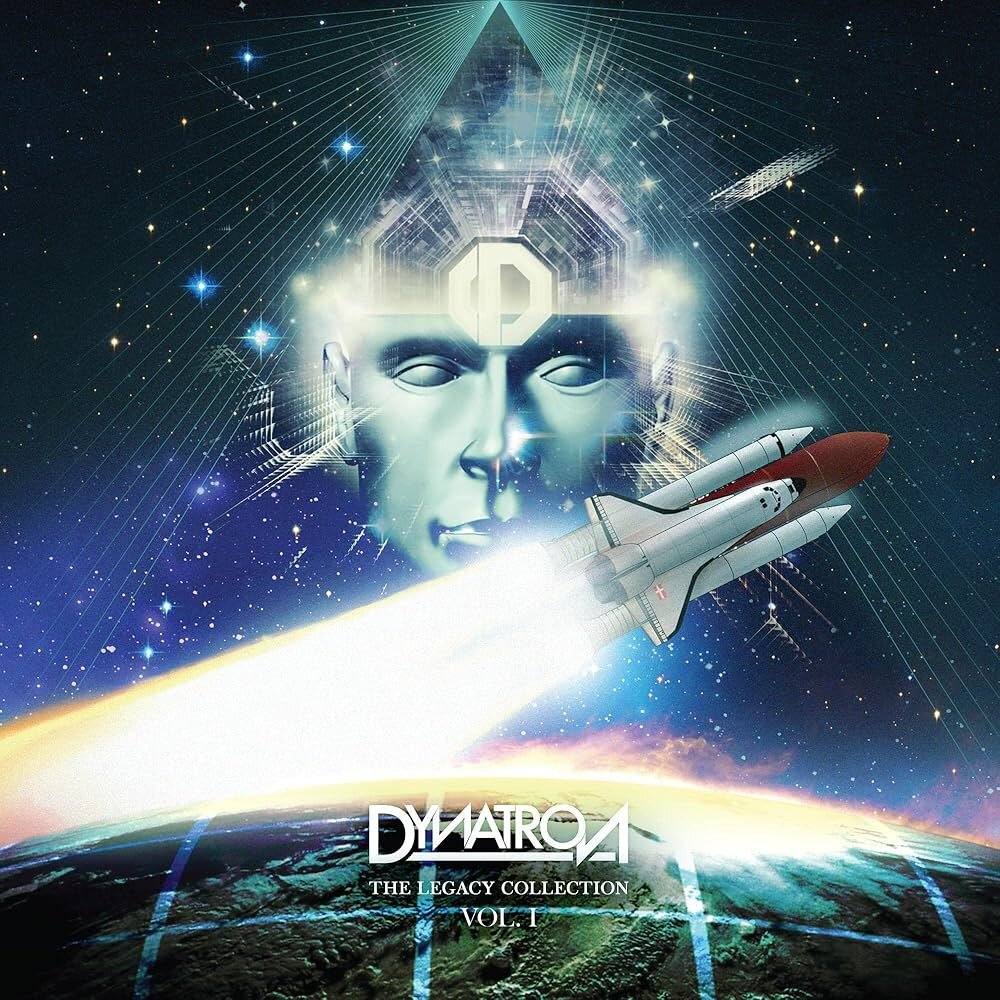
Towards The Island Universe
By Dynatron
(The Legacy Collection)
Features
The revamp isn't just in the appearance, but Matrix Audio has made the new X-SABRE 3 competitive with the latest streaming technology and features. Like its predecessor, the DAC is Roon Ready certified, requiring very little to set up and giving you access to bit-perfect audio. With the Roon app, you can also control the payback, output volume, and standby all from your phone or smart device. With software that supports UPnP or DLNA, you can stream with the original sampling rate in the local area network to the X-SABRE 3.
The X-SABRE 3 is also the first in Matrix Audio's product line to include Tidal Connect and Spotify Connect. You can select the unit as a playback device with your streaming service and enjoy all your favorite high-resolution audio in stunning detail. The inclusion of streaming integration is nice as more services are offering high-resolution audio options, it's a welcome addition to the overall value of such a device.
Sync and Async mode - Switching of the working mode of the D/A chip can be conveniently done through the touch panel of X-SABRE 3. In the Async (asynchronous) mode, the master clock of the D/A chip comes from the excellent Crystek CCHD-950 femtosecond clock inside the X-SABRE 3, and the clock from the front-end device will be abandoned; in the Sync mode, the built-in femtosecond clock is turned off, and the D/A chip depends on the clock of the front-end device completely. In this mode, with a high-quality digital interface, you can bypass the digital processing part of the DAC through the IIS-LVDS interface, send the digital audio stream directly to the D/A chip to achieve different experiences.
Trigger - The streaming capabilities of the X-SABRE 3 allow more ease of control via your mobile phone. The standard Trigger port disables the need to turn on and off the power amplifier manually. When the X-SABRE 3 in powered on or entered standby, it will also turn on or off any connected 12V trigger device automatically. In a world looking for automated solutions, the triggers are a nice option to integrate into your system.
Startup Tips
It's important to note that the X-SABRE 3 DAC ships with outdated firmware. Since its release, there have been numerous reported bugs and the team at Matrix Audio has been prudent to put out quick fixes via firmware updates. Here's what you'll need to do to get your X-SABRE 3 up and running with the latest updates: Go to:
- > Settings
- > 16. Firmware Update
- > Check for Updates
- > Update latest firmware
- (At the time of writing the latest firmware is Build44)
Be sure to regularly check for firmware updates as it will keep your device running optimally. Also, be sure to check the voltage switch before powering on your device for the first time. The X-SABRE 3, like its predecessor, is compatible with AC100-120V and AC220V-240V voltage specifications. Please make sure to set the bottom power voltage switch (under the device) according to your local voltage environment before plugging in the power supply and using it.
Comparisons
The biggest thing to note here is that whereas the original X-SABRE and the new X-SABRE 3 utilize the same DAC (ES9038PRO), don't make the mistake of thinking it sounds the same. The new design of the X-SABRE 3 incorporates isolation between the power, digital, and analog circuitry. This results in a phenomenally low noise floor and overall better protection from interference. It's a substantial design improvement that doesn't stop there. Filters, buttons, and power all stay the same, but the design elements are where the X-SABRE 3 really shine. The tempered glass and new full-color LCD screen are the biggest takeaways, making the device more premium than ever.
Despite using the same flagship DAC chip, the new design creates for a more resolute and dynamic listening experience, in part due to the THD and SNR numbers. It's a small difference, but a welcome one for those wanting the purest signal and overall quality. Another important addition is the integration of streaming services like Tidal and Spotify. With the latest streaming services offering high-resolution audio, it's hard to imagine audiophiles going without at least one streaming subscription for the library alone. These features really help the X-SABRE 3 seem like a worthwhile quality-of-life upgrade from its predecessor.
Dragon Cables
There are a couple options of here when it comes to replacing the OEM cables. Of course, we always recommend upgrading because most stock cables are made of poor, ultra-thin conductors with poor geometries, rubber jackets, and other issues that can limit the performance of your equipment. When it comes to USB connection to your device, both Silver Dragon USB and Black Dragon USB cables would make excellent choices due to the nature of the cables being built to audio transfer specs. Be assured due to the quality of materials we use that your data packet transfers will be more efficient and reduce jitter. For your line output, it more so depends on the kind of music you like to listen to. The basic rule of thumb is this: you like a more musical and warm presentation to balance out the detail of the X-SABRE 3, go with the Black Dragon Interconnect. If you're a detail junkie and like a more analytical interpretation, go with the Silver Dragon Interconnect. As always, feel free to Contact Us with any questions you may have and we'll make a personalized recommendation for you and your system.
Verdict
The X-SABRE 3 DAC is an upgrade in every sense of the word from the previous generation DAC. Matrix Audio has put a tremendous amount of effort into improving one of the best DACs on the market and making it even better, more resolute, and packed with the latest features bringing it up to date putting it ahead of the competition. The addition of Tidal and Spotify connect, combined with Roon Ready certification make the X-SABRE 3 the perfect hi-res streaming host to add to your system. The DAC is one of the best sounding on the market - hands down - and will provide a level of detail and clarity few DACs can match.
At $2,999, the X-SABRE 3 MQA DAC from Matrix Audio isn't cheap, but you certainly get what you pay for here. It's one of the best standalone DACs you can get and it's hard not to get excited when listening to music through it. Compare it to seeing an IMAX film for the first time after watching movies on an old CRT screen: an infinite amount of pixels, details, resolution, and depth that you never knew was there.
Yeah - it's just that good.
Featured Products
Related Videos
Matrix Audio X-SABRE 3 DAC Review
Matrix Audio Element Series Spotlight at #AXPONA
Matrix Audio Element S Review: The Most FUTUREPROOF Streamer?
What's in the Box
Specifications
Hardware Platform
- CPU: NXP i.MX 6Quad 4x Cortex-A9 @1.2 GHz
- D/A Chip: ESS ES9038PRO
- Clock Source: Crystek CCHD-950
Digital Input
- Coaxial & Optical: PCM 16-24Bit /44.1kHz, 48kHz, 88.2kHz, 96kHz, 176.4kHz, 192kHz
- DSD 2.8MHz (DoP)
- IIS LVDS (not HDMI): PCM 16-32Bit /44.1kHz, 48kHz, 88.2kHz, 96kHz, 176.4kHz, 192kHz, 352.8kHz, 384kHz, 705.6kHz, 768kHz
- DSD 2.8MHz, 5.6MHz, 11.2MHz (DoP)
- DSD 2.8MHz, 5.6MHz, 11.2MHz, 22.4MHz (Native)
- USB Audio: PCM 16-24Bit /44.1kHz, 48kHz, 88.2kHz, 96kHz, 176.4kHz, 192kHz, 352.8kHz, 384kHz, 705.6kHz, 768kHz
- MQA 16-24Bit /44.1kHz, 48kHz, 88.2kHz, 96kHz, 176.4kHz, 192kHz, 352.8kHz, 384kHz MQA or MQA Studio stream
- DSD 2.8MHz, 5.6MHz, 11.2MHz (DoP)
- DSD 2.8MHz, 5.6MHz, 11.2MHz, 22.4MHz (Native)
Line Output (pre-amp)
XLR
- SNR: >-134dB
- THD+N: <0.00010%@1k, <0.00025%@20Hz-20kHz
- Frequency Response: 20Hz-20kHz ±0.05 -3dB@86kHz
- Channel Crosstalk: >-151dB
- Analog Output Amplitude: 4.8VRMS@0dB
RCA
- SNR: >-128dB
- THD+N: <0.00015%@1k, <0.00025%@20Hz-20kHz
- Frequency Response: 20Hz-20kHz ±0.05 -3dB@86kHz
- Channel Crosstalk: >-138dB
- Analog Output Amplitude: 2.4VRMS@0dB
Network
- LAN: 10/100/1000Mbps
- WLAN: 2.4GHz/5GHz
MA player Lite
- Roon Ready
- PCM 16-24Bit /44.1kHz, 48kHz, 88.2kHz, 96kHz, 176.4kHz, 192kHz, 352.8kHz, 384kHz, 705.6kHz, 768kHz
- MQA 16-24Bit /44.1kHz, 48kHz, 88.2kHz, 96kHz, 176.4kHz, 192kHz, 352.8kHz, 384kHz MQA or MQA Studio stream
- DSD 2.8MHz, 5.6MHz, 11.2MHz, 22.4MHz
- AirPlay 2: The audio specs depend on the service provider
- DLNA/UPnP: The audio specs depend on the service provider
- Tidal Connect: The audio specs depend on the service provider
- Spotify Connect: The audio specs depend on the service provider
Weight and size
- Weight: 3.4 kg (7.49 pounds)
- Size
- Width: 310 mm (12.20 inches)
- Depth: 218 mm (8.58 inches)
- Height: 43 mm (1.69 inches)
Power
Power Voltage
- 230V position is fit for AC 220V-240V 50/60Hz
- 115V position is fit for AC 100V-120V 50/60Hz
Standby Power Consumption: < 4W
Maximum Power Consumption: < 33W




